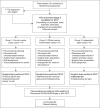Mentoring a surgical team towards procedural competence in the early learning curve for selective fetoscopic laser photocoagulation
- PMID: 36043312
- PMCID: PMC9297184
- DOI: 10.11622/smedj.2020137
Mentoring a surgical team towards procedural competence in the early learning curve for selective fetoscopic laser photocoagulation
Abstract
Introduction: Selective fetoscopic laser photocoagulation (SFLP) for twin-to-twin transfusion syndrome (TTTS) is challenging for new surgeons at the start of their learning curve. We described an approach utilising telementoring and team-based training to facilitate rapid attainment of the skills required for safe and efficient practice with a limited caseload.
Methods: We conducted a prospective observational study of SFLP performed by the novice primary surgical team in three stages: under direct on-site supervision from an expert mentor (Group 1), with remote tele-guidance from that mentor (Group 2) and independently (Group 3), at an academic tertiary hospital in Singapore. The primary team undertook regular training on high-fidelity tissue models to accelerate skills acquisition and complement the surgical performance.
Results: 9 patients diagnosed with Stage 2 TTTS were assessed for procedural characteristics, surgical outcomes and perinatal survival following SFLP. There were no significant differences in operative duration, anastomoses ablated, gestational age or birth weight at delivery. The complications observed were: recurrent TTTS (22.2% of pregnancies), twin anaemia polycythaemia sequence (33.3%), preterm prelabour membrane rupture (22.2%) and delivery at < 32 weeks (44.4%). ≥ 1 twin was live-born in 88.9% of cases, while postnatal survival to six months of ≥ 1 twin occurred in 77.8% of cases.
Conclusion: Systematic mentoring and specialised skills training are useful in aiding new surgeons to negotiate the steep learning curve and achieve good outcomes at the start of a new practice, particularly in the setting of low patient numbers. This is best paired with dedicated model training to achieve and maintain surgical dexterity for this complex procedure.
Keywords: fetoscopic laser photocoagulation; fetoscopy training; learning curve; surgical mentoring; twin-twin transfusion syndrome.
Copyright: © Singapore Medical Association.
Conflict of interest statement
We would like to thank Zhenzhi Chen, Pei-Huang Kuan, Sister Li Li Tan, Cecille Arquillo Laureano, Maylene Tan Zipagan and the residents of the Department of Obstetrics and Gynaecology, National University Hospital, Singapore. This work was supported by funding from the Department of Obstetrics and Gynaecology, Yong Loo Lin School of Medicine, National University of Singapore, Singapore.
Figures



Similar articles
-
[Pregnancy outcome after fetoscopic laser photocoagulation for twin-twin transfusion syndrome: experience of an emerging center from China].Zhonghua Fu Chan Ke Za Zhi. 2014 Jun;49(6):404-9. Zhonghua Fu Chan Ke Za Zhi. 2014. PMID: 25169629 Chinese.
-
Selective Fetoscopic Laser Photocoagulation or Expectant Management for Stage I Twin-Twin Transfusion: A Cost-Effectiveness Analysis.Fetal Diagn Ther. 2022;49(9-10):394-402. doi: 10.1159/000527414. Epub 2022 Nov 15. Fetal Diagn Ther. 2022. PMID: 36380641
-
[Fetoscopic laser coagulation in 200 consecutive monochorionic pregnancies with twin-twin transfusion syndrome].J Gynecol Obstet Hum Reprod. 2017 Feb;46(2):175-181. doi: 10.1016/j.jogoh.2016.10.004. Epub 2017 Jan 30. J Gynecol Obstet Hum Reprod. 2017. PMID: 28403975 French.
-
Perinatal risk factors of neurodevelopmental impairment after fetoscopic laser photocoagulation for twin-twin transfusion syndrome: systematic review and meta-analysis.Ultrasound Obstet Gynecol. 2021 Nov;58(5):658-668. doi: 10.1002/uog.23706. Ultrasound Obstet Gynecol. 2021. PMID: 34097320
-
Balancing Patient Access to Fetoscopic Laser Photocoagulation for Twin-to-Twin Transfusion Syndrome With Maintaining Procedural Competence: Are Collaborative Services Part of the Solution?Twin Res Hum Genet. 2016 Jun;19(3):276-84. doi: 10.1017/thg.2016.24. Epub 2016 Apr 18. Twin Res Hum Genet. 2016. PMID: 27087260 Review.
Cited by
-
Virtual Reality Simulation in Teaching Fetoscopic Laser Placental Photocoagulation in Twin-To-Twin Transfusion Syndrome.Prenat Diagn. 2025 Jun;45(6):772-777. doi: 10.1002/pd.6807. Epub 2025 May 1. Prenat Diagn. 2025. PMID: 40312147 Free PMC article.
-
Resilience amidst winds of change.Singapore Med J. 2022 Jan;63(1):1. doi: 10.11622/smedj.2022022. Singapore Med J. 2022. PMID: 35466384 Free PMC article. No abstract available.
References
-
- Simpson LL Society for Maternal-Fetal Medicine. Twin-twin transfusion syndrome. Am J Obstet Gynecol. 2013;208:3–18. - PubMed
-
- Baschat A, Chmait RH, et al. WAPM Consensus Group on Twin-to-Twin Transfusion. Twin-to-twin transfusion syndrome (TTTS) J Perinat Med. 2011;39:107–12. - PubMed
-
- Ropacka M, Markwitz W, Blickstein I. Treatment options for the twin-twin transfusion syndrome:a review. Twin Res. 2002;5:507–14. - PubMed
-
- Quintero RA, Kontopoulos E, Chmait RH. Laser treatment of twin-to-twin transfusion syndrome. Twin Res Hum Genet. 2016;19:197–206. - PubMed
-
- Donepudi R, Akkermans J, Mann L, et al. Impact of cannula size on recurrent twin-twin transfusion syndrome and twin anemia-polycythemia sequence after fetoscopic laser surgery. Ultrasound Obstet Gynecol. 2018;52:744–9. - PubMed
Publication types
MeSH terms
LinkOut - more resources
Full Text Sources

